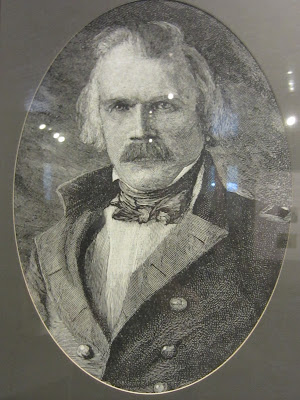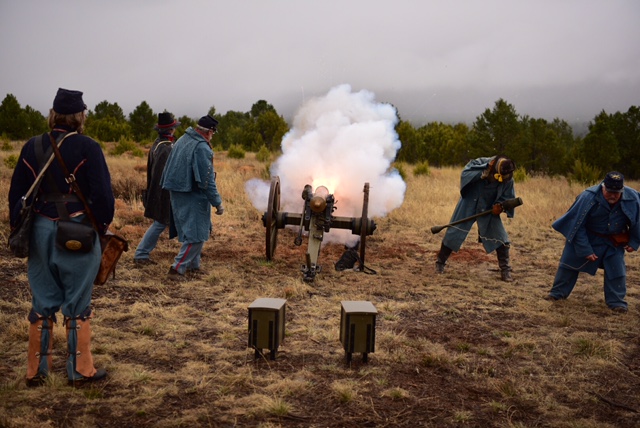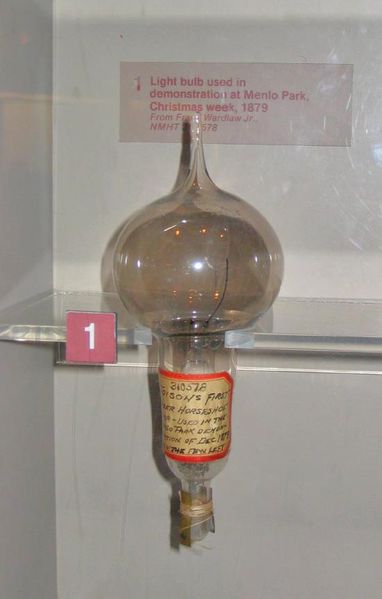As with almost all the Civil War battlefields preserved by
the National Park Service, Antietam lies serene with its well-maintained fields
and copses of trees. The place bears no resemblance to the ferocious place of
death and destruction in 1862. To this day, Antietam remains the single
bloodiest one-day battle in our nation’s history, worse even than D-Day or Iwo
Jima in World War II. The Confederate defeat here ended Lee’s first invasion of
the North and set the stage for Lincoln to issue the Emancipation Proclamation.
Like other battlefields, Antietam place bears silent witness to the thousands
of men killed in the savage fighting in these hills, swales, and streams.
 |
| The battlefield at Antietam (Photo by Hunner) |
Lee invaded Maryland for several reasons: first, he wanted
to rattle the North by taking the war to their homeland. Second, the rich
farmland of Maryland beckoned as a cornucopia. Third, a successful invasion
might open the door to foreign recognition of and support for the Confederacy.
The South’s victory at Second Manassas opened the route
north. Lee’s plan called for the Army of Northern Virginia to split in two,
with General Stonewall Jackson’s troops going to Harper’s Ferry and the rest
heading farther north. However, the Union forces at Harper’s Ferry held out
longer than expected. Complicating the invasion, Union soldiers found Lee’s secret
battle orders in a muddy field, wrapping three cigars, but Union General
McClellan failed to exploit Lee’s divided army. The invasion stalled near the
town of Sharpsburg, and Lee considered retreating to Virginia until news reached
him that Harper’s Ferry had finally fallen. With those Confederate troops now
free to rejoin his army, Lee braced for battle with nearly 30,000 troops.
McClellan’s army held 60,000 men with another 15,000 in reserve nearby.
 |
| General Robert E. Lee (From exhibit at Antietam's Visitors' Center) |
The Battle of Antietam took place in three phases. First, at
the Cornfield and the North Woods at the north end of the battlefield, the
armies clashed with ferocious intensity. Then as the Northerners pressed in from
the east, the Confederates regrouped in a sunken farm road afterwards known as the
Bloody Lane. And finally at the southeast part of the battlefield, just when it
looked like the North would crack the Confederate right, more Southern reinforcements
rushed from Harper’s Ferry shored up their defenses. As Civil War historian
James McPherson notes: “The fighting at Antietam was among the hardest of the
war.”[1]
 |
When I visited Antietam at the end of August, I sat behind
the Visitors’ Center looking out over the battlefield as Chief Ranger Keith
Synder sketched out the action. The first phase of the battle took place over
five hours during the morning of September 17, 1862. Wading through a ripened
corn field, five Union divisions slammed into five Confederate divisions which
resulted in 12,000 men dead or wounded. The combat so shattered these divisions
that they backed off, and few of those survivors rejoined the fighting that
day.
By midday, the battle had shifted to the center of the lines
as Confederate soldiers ducked into a sunken road to resist the Union onslaught
at the Bloody Lane. After a determined resistance, this fell to the advancing troops
in blue. A northern war correspondent who arrived right after the Union
captured the road commented: “Confederates had gone down as the grass falls
before the scythe.”[2]
Those who escaped fled to nearby Sharpsburg to regroup.
General Burnside commanded the Union left on the southeast
section of the battlefield. As a divisionary action, he tried to pin down
Confederates so that they could not reinforce the fighting to the north.
Instead, the Georgia troops on a hillside above a strategic bridge devastated
the squads of Union soldiers who tried to rush across. After many delays, the
Union took the bridge and also forded the Antietam Creek at nearby fords and
forced the Southerners back.
 |
| Burnsides' Bridge from the rifle pits that the Georgians used to pick off the Union soldiers as they tried to cross it. (Photo by Hunner) |
Just when it seemed that the Union troops were
going to roll up the Confederate right flank, General A.P. Hill’s men arrived
from Harper’s Ferry and blunted the North’s advance. The next day, both sides
stayed in the area without any major engagements. Each side had suffered much
in the one-day battle—17,000 wounded and 6,000 dead or dying. Nearly one-third
of the Confederates who marched north became causalities. Both sides reeled from
such losses, which perhaps explains why McClellan failed to capture the exhausted
Southern army which retreated to Virginia.
The number of dead and wounded shocked the public. The toll
was horrendous—as McPherson says: “The causalities at Antietam numbered four
times the total suffered by American soldiers at the Normandy beaches on June
6, 1944. More than twice as many Americans lost their lives in one day at
Sharpsburg as fell in combat in the War of 1812, the Mexican War, and the Spanish
American War combined.”[3]
As the Civil War intensified, the body count mounted.
 |
| A Confederate cannon facing towards Burnsides' Bridge in the southern part of the battlefield (Photo by Hunner) |
One of the most lethal weapons on the Civil War’s
battlefields was artillery which constituted its own branch of the army. Well
placed cannons anchored an army’s position and blunted enemy attacks.
Effective
use of artillery required a well-trained set of soldiers and horses. A battery
consisted of four to six guns manned by seventy to one hundred soldiers. Each
unit consisted of a cannon, one or two limbers which carried between thirty and
fifty rounds of ammo each, and a caisson with spare wheels and more ammunition.
The limbers and caisson held between 120 to 200 rounds. The cannon, limber, and
caisson in various combinations were pulled by six or more horses which made these
weapons quickly responsive to a fluid battlefield.
| Caisson and limber for a Civil War cannon (From Civil War Trust website) |
A cannon crew consisted of seven men. Four surrounded the
gun with the Gunner in charge of aiming and giving commands. The other three at
the gun washed and cleared the bore after every shot, rammed the ammunition and
shell down the barrel, primed the powder bag, and lit the fuse or pulled the
lanyard to fire the weapon. The final three in the crew ran ammunition from the
caisson and limber (which were detached behind the cannon) to the gun and
prepared the charges and fuses.
Two types of cannons blasted away during the war. Smoothbore
guns fired round cannon balls. Rifled cannons had grooves cut inside the
barrels which gave a spin to the fired round and proved more accurate. The
range of many of the cannons at Antietam was around one mile.
These guns used four types of ammunition depending on the
target. Smoothbores fired round shots while the rifled cannons used shells that
looked like large bullets. Some ammo were solid projectiles while others had a
fuse that exploded at its destination and scattered shell fragments. Case
ammunition consisted of a shell packed with small balls that scattered once the
fuse detonated while a canister shot contained golf ball size iron balls.
Canister was used at close range—when soldiers were 100 to 300 yards away.
Sometimes, the guns fired on opposing batteries to disable their enemy’s guns.
Often however, cannons focused on charging infantry to disrupt advances.[4]
At Antietam, more than 500 cannons spewed lethal metal into
the opposing side. Over 3,000 rounds per hour were fired, creating such a
booming that “soldiers described the day as a ‘savage continual thunder’ and a
‘tumultuous chorus.’”[5]
The effect of cannon balls, shell fragments, case, and canister on the human
body was devastating.
As the Confederate army retreated, and the Union forces
maneuvered to protect D.C., President Lincoln used the Union’s victory as an
opportunity to issue the Emancipation Proclamation. On September 22, he issued
a preliminary order which declared that on January 1, 1863, “all persons held
as slaves within any state, or designated part of a state, the people whereof
shall be in rebellion against the United States, shall be then, thenceforward
and forever free.” This executive order focused on slaves in the Confederacy,
but obviously, few if any were at first freed. The Emancipation Proclamation
also opened the door to Blacks serving in the military of the United States.
The Proclamation changed why the United States fought. Prior
to issuing it, Lincoln said: “My paramount object in this struggle is to save
the Union and is not either to save or destroy slavery.”[6]
On January 1, 1863, the reason for fighting officially shifted to ending
slavery on the continent. Slaves did free themselves by escaping from
plantations and walking to Union camps or the north. It would take another two
and a half years of war to defeat the Confederacy and end slavery. Next week, I will explore the impact that war deaths have on those left behind while in future weeks we will visit Chattanooga and the other battlefields in the Civil War. Having said this, I am now finishing up my sabbatical and road trip. I am not sure how much longer I can continue to post a blog every week, especially once I start teaching again in January. I am also figuring out how to turn this into a book. Please let me know any ideas you have about both my blog as well as what you would like to see in a book.
 |
| Cannon at Antietam (Photo by Hunner) |
[1]
James McPherson, Battle Cry of Freedom (New
York: Oxford university Press, 1988), 540.
[2]
McPherson, Battle Cry,” 541.
[3]
McPherson, Battle Cry of Freedom,” 244.
[4]
“Artillery at Antietam.”
[5] Keith
Snyder, “Artillery at Antietam,” a brochure published by the Western Maryland Interpretive
Association.
[6]
George Tindall and David Shi, America: A
Narrative History, (New York: W. W. Norton
& Company, 1984), 720.


















































